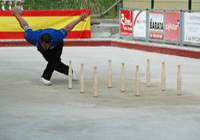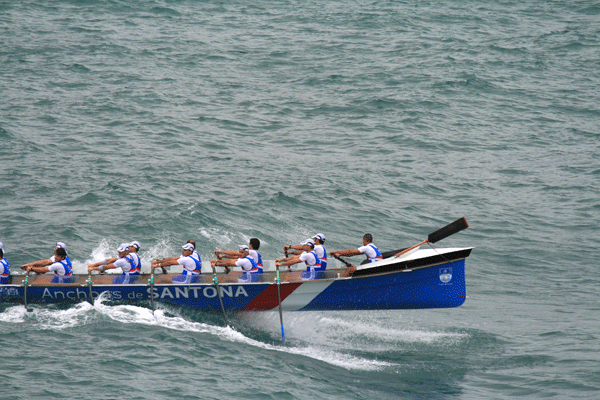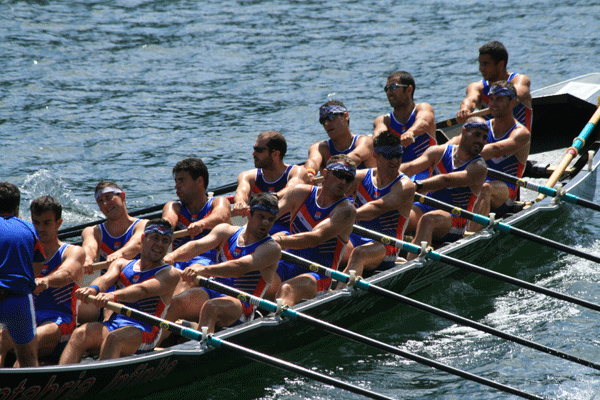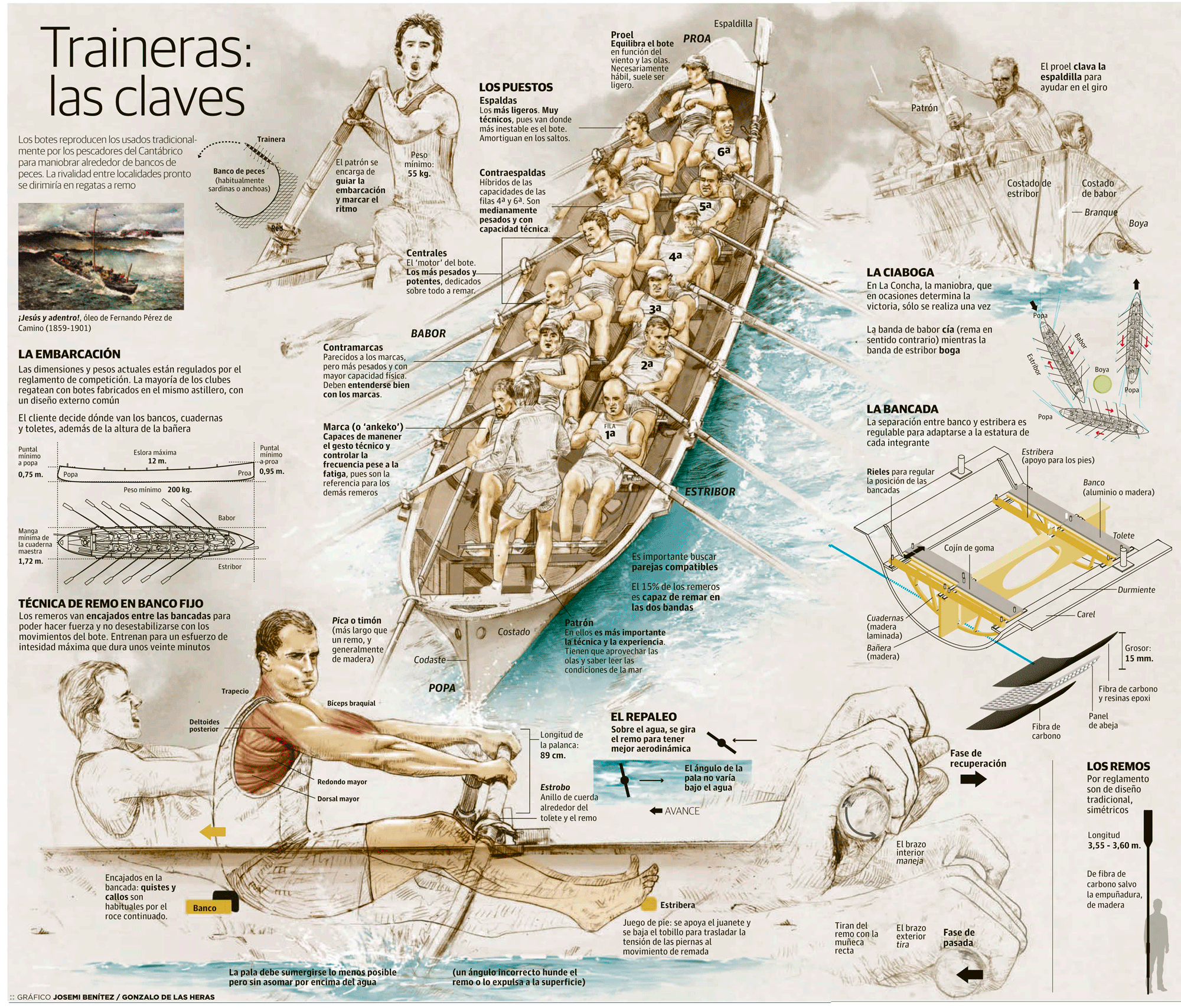HISTORY
It is believed the origin of this type of bowling is german and it arrived to our soil through the Camino de Santiago pilgrims. Although, the first known reference is a 1627 public anouncement on the Ayuntamiento de Santander´board, by which whoever dared to play it on Santander´s street would be fined with 200 maravedíes (Spanish coin while under the Moors occupation). This fine is believed to have been directed to the avoidance of traffic jams on the port.
From this date other fines and comments appear on the boards, such as in Ampuero: “No resident must play the game on a working day, day or night, or bank holidays untill High Mass is finished …”. The town of Puente San Miguel is where, at the end of the XIX century, the first Bowling Game Regulations with 12 articles, is published.
In 1919 the Federación Bolística Montañesa regulates the game, corrects bad habits and unifies the game conditions.
In 1941, the Federación Española de Bolos is funded in Madrid followed by the Cantabrian one a few months later. From 1958 the league competitions and the creation of clubs with the game categories legislation are established.
THE GAME
We could diefine the Bolos as a game of precise throw. There are four different categories: bolo palma (most extended throuhg out the region), pasabolo tablón (practiced mainly on the Rivers Asón and Agüera basins, in the eastern area of Cantabria and in the areas of Campoo and Valderredible), pasabolo losa (practiced in the region of Trasmiera) and bolo pasiego (Valles Pasiegos).
To explain the game plainly we group these four categories in two modalities, one is thetiro y birle and the other onepasabolos:
De tiro y birle, is where you find bolo palma and the bolo pasiego. There are two game stages, one refereing to tiro in which the ball is thrown from the tiro area towards the 9 bowling pins that form a square and towards a smaller bowling pin called emboque o cuatro (depending on the modality). Afterwards another throw called birle is made..
From pasabolos, here we can find the pasabolo tablón and pasabolo losa. It is a modality of bowling based on strenght to throw the bowling pins as far as possible to reach most points (determined by the reached distance on each throw).
Next, we will detailbolo palmafurther, as it is a complex modality. It is practiced almost everywhere in Cantabria and the eastern area of Asturias although, Santander and Torrelavega is where the tradition is greater and the number of participants and bowling alley exist.
This modality holds the most important and busy competitions with numerous prizes, so that some players could be considered professionals.
Ther is a league played between clubs and individual or by couples championships. Cantabria has a great quantity of players on each category, including juvenil, junior, childrens, beguiners, female and undergraduates.
The bowling alley is a enclosure of around 36 x 6 mts, (measurements can vary depending on the modality), bordered around the perimeter to avoid balls going free and hurting spectators. Bowling alleys are generally situated within plazas o near a church and they are surrounded by trees for shading from the summer sun, concluding the season towards the end of October. Over the past few years covered bowling alleys have been built due to the demand from the existing supporters of the game to be played all year round.
Bowling alleys are generally situated within plazas o near a church and they are surrounded by trees for shading from the summer sun, concluding the season towards the end of October. Over the past few years covered bowling alleys have been built due to the demand from the existing supporters of the game to be played all year round.
The game It consists in knocking down as many bowling pins as possible with two throws: the throw from the zona de tiro and el birle, from the place the ball stops. It cana be played individually, in twos or in fours. In addition, it can be played as free play or as a competition.
The game is played with 9 birch or hazelnut wood bowling pins plus the emboque (smaller bowling pin). To knock the bowling pins down wooden balls are used, generally made with oak wood, they weight between 1.700 and 2.300 grs and the distance of throw vary between 14 to 20 mts. The bowling pins are placed or ´planted´ in the central area called caja, with a separation of 65 to 74 cm between them. The bowling pins are situate after a metal board called fleje, which determines the balls have to pass it to be a valid trhow. The throwing spots are on a concrete slab, with marks to delimit 20 mts lenght. There should be a free area of 12 mts behind the rows of bowling pins, so the balls stop and the birle can be made.
Topunctuate the throw must be valid and for that to happen the ball must pass the fleje (short ball), throw with the adecuate effect (hand or thumb), not to go over the last row of bowling pins (long ball), pass the mark and not to knock down any outside bowling pin row (oppose to the emboque) or the first on line nearest to the emboque.
All knocked down bowling pins are worth 1 point each, except the central bowling pin which, if knocked down by itself, it is worth 2 points. The emboque can only be knocked down from the tiro, as in the birle this is taken away. When knocked down, it si worth 10 points. For this reason the first bowling pin of the middle row must be knocked down, diverting its trajectory and knocking donw the emboque.
Interesting links
http://www.efdeportes.com/efd191/juegos-de-bolos-en-cantabria-bolo-palma.htm
http://desdecantabria.blogspot.com.es/2007/11/juego-de-los-bolos-en-cantabria.html
PASABOLO TABLON

PASABOLO LOSA

BOLO PALMA

BOLO PASIEGO

ORIGINS
Traditional sport in the north of Spain, rowing is practiced in some of the municipalities that form the MMS.
Its origins date from the mid 18th century and consisted in a typical vessel of fine lines, high prow and round poop, propelled by rowing or sailing (for fishing), depending on the use.
The vessels, once the fish had been cought, went to great lenghts to get back to port as fast as possible, to unload the fish and sell it at the highest price. This is how first rowing competitions were born around the Cantabrian coast.
FEATURES
The traineras are composed by 1 captain and 13 rowers, who were distributed in 6 rows of 2 rowers and 1 more rower by himself in prow, in the inner thwart. In each thwart, except in prow, a rower rows on the left side and the other on the right side backstroke, facing poop. The captain stays generally in poop facing prow and directs the vessel with the tiller.
The overall weight of teh vessel including the tholepin, thwart and the rowlock must be 200 kgs. The material used to make the vessel has varied over time from wooden to carbon fiber rows. The making process takes at least a month and a half by first making a scaled blueprint based on standar the measurements of 12 mts of lenght, 95 cms of prow, 75 cms of poop and 60,5 cms of depth.
There are similar vessels where the only difference is the number of rowers such as the batel (1 captain and 4 rowers) and the trainerilla (1 capatin and 6 rowers).
COMPETITION
The regatta field is an imaginery rectangule with 4 buoys on the exit mark and 4 bouys along the opossite to mark the place where the vessel must turn around. Before the start of each regatta the lanes are given with a raffle. Depending on what lane they are given it could be windier or with stronger currents.
The competition consists in running 4 lenghts from the starting point to the turning point, a total distance of 5.556 mts, turning 3 times in such way that the buoy is poop to the vessel. Once the bouy marking the end of the lenght is reached the rowers on the right continue rowing while the rowers on the left start turining at a very close angle.
The traineras seasons is mainly during the summer, once the batel and trainerillas season end. There are provincial and regional championships, as well as the national championship called la Bandera de La Concha nominated “Olimpiada del remo” which ocurred in Sebastián the first two Sundays of September.







